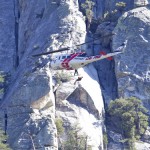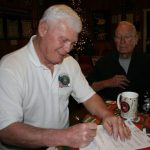Artist and teacher Rebecca Peck Jones died in her sleep Sunday, Oct. 22, 2006 at her Riverside home. Rebecca was best known for her clay art and pottery, which she described as “a form of spiritual beauty that is concrete. You can drink out of it, eat out of it or hang it in your garden.”
She also had a passion for teaching and was co-founder of Riverside County’s high school art contest. She began art lessons at 12 in New Milford, Conn., with noted landscape and graphic artist Edith Newton. By her 20s, she had graduated with a master’s degree in fine arts from the prestigious Chouinard Art Institute, now California Institute of the Arts (Cal-Arts).
She continued to study art at numerous universities and to attend workshops with such notables as California watercolorist Rex Brandt and ceramic artist Marguerite Wildenhain, who was associated with the avant-garde Bauhaus School in Germany.
In the 1950s, Rebecca was a staunch supporter and participant at the Dog Pound, a 4-acre site at the old Riverside animal shelter on 14th Street, that artists leased from the city for $1 a year. (In 1967, the Riverside Art Museum replaced it.)
The Dog Pound had space for the type of free-wheeling sharing of creativity, knowledge, and arts and crafts equipment that Rebecca admired about Bauhaus. Rebecca taught art through many venues, beginning with the Telfair Art Academy that she helped to establish in Savannah, Ga., now Telfair Museum of Art.
In Riverside, she taught ceramics and sculpture at California Baptist University and in her private studio. She treasured the time she worked as assistant to Ray Miller, art director for the Riverside Unified School District and the Riverside Art Museum.
Earlier in her career, she edited the company magazine for Hunter Douglas Corp. and worked as an artist and writer for Pacific Mutual Life Insurance Co. in Los Angeles.
Rebecca sought to learn, work and understand “the spiritual side of life and mud” and to translate these ideas into clay. Some of her most compelling works were of the women, children and animals she sketched in Cairo, Egypt, and Amatenango del Valle, a tile and adobe village in Chiapas, Mexico.
“I’ve always loved the human form, gesture drawings,” she explained of her work. “I base everything on spiritual development. I think the bottom line is your own spiritual evolution and how you relate to something that centers your life and is meaningful.”
Rebecca was a lifelong Christian Scientist and was influenced by the writings of Mary Baker Eddy, Albert Einstein, Henry David Thoreau and Russian artist Wassily Kandinsky.
Rebecca made most life decisions for art’s sake. For instance in 2001, she left her beloved “Gopher Grove,” the 1-acre parcel in the green belt of Riverside she had shared with her late husband, Sims Jones. She moved to Idyllwild, a village with many artists and galleries, where she could spend more time throwing pots and creating clay sculpture and less time tending to yard and housework.
Rebecca moved back to Riverside during “a bad patch,” as she good-humoredly called hard times. This was a temporary stop on her way to live in a Laguna Hills community with many artists, for, as she said, “Art comes from within, but the environment has a lot to do with it.” She was not taking her kiln — throwing pots had become too arduous — and had returned to drawing and watercolor. Rebecca looked forward to living and working among artists: “Joy, oh bliss,” as she liked to say about the good things coming her way.
She is survived by her husband, Don O’Neill; two stepsons, Richard S. Jones and Clayton S. Jones; two nieces, Cynthia Hodge Johnson and Linda Peck Smith; and two nephews, Robert L. Peck II and Andrew K. Peck. According to Rebecca’s wishes, the Neptune Society is handling cremation with her ashes to be dispersed.
Because art develops, and it is timeless and ageless, a Web page has been created to honor the art and life of Rebecca Peck Jones at urs2.net/rsj/memorial. Friends and admirers are invited to e-mail their reminiscences to [email protected].










